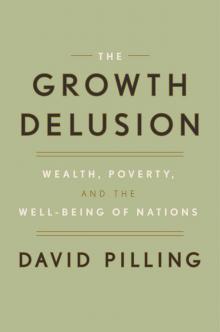- Home
- David Pilling
The Growth Delusion Page 7
The Growth Delusion Read online
Page 7
A process now known by the hideously ugly term “financialization” took hold. Anonymous capital markets replaced the once-simple relationship between borrower and lender. New products sprang up to fill this new market, including complex derivatives, or bets on the future movement of prices. Soon banks were talking a new language of forward exchange rates, credit default swaps, and collateralized debt obligations. The less ordinary people understood about what was really going on the better. I remember in the mid-2000s being lectured by senior bankers who explained to me condescendingly how derivatives were making the world a safer place by spreading risk to the four corners of the earth. But like Easter eggs hidden in sundry parts of the garden, it wasn’t long before everyone forgot where they were hidden—or precisely what color or shape the eggs were. Just for good measure, in keeping with those buccaneering times, the market in derivatives was not regulated at all.
Banks’ biggest customers were each other in an insane shuffling of paper that added virtually nothing to real economic activity (properly measured). The vast bulk of bank assets were actually claims on other banks. In Britain actual lending to businesses and individuals engaged in productive activity amounted to about 3 percent of total assets.14 That left the other 97 percent. What’s more, banks were horribly incentivized to keep up the game of pass the parcel. From the bankers’ perspective, there was no downside. If a bet came off, they would be rich beyond imagination—and praised as wealth-creating geniuses to boot. And if it didn’t come off, well, what was the worst that could happen?
It turned out that the worst was the near-collapse of the entire financial system, a meltdown arrested only by taxpayer bailouts worth hundreds of billions of dollars. Banking, as has been said by more than one person, is socialism for the wealthy and capitalism for everyone else.
Throughout the whole hideous expansion, conventional economics was sending but one signal: Bigger is better. Banking’s apparent contribution to the economy had seduced politicians for decades. When the industry blew up, the debt was transferred from private banks to the public purse. A whole generation was saddled with the bill, both in higher taxes and in lost economic opportunity. One report put the cost of the financial crisis at between one and five times annual world output.15
That brings us to the second, slightly more technical, matter of the way we account for banking activity in our national accounts. The system that has evolved is perverse. It stems from the fact that banks do not charge fees for many of their activities. If a bank lends you money, it may charge a one-off fee. But the bulk of its revenue comes from what is called the spread—the difference between the interest rate it charges you and the interest rate at which the bank itself can obtain money.
To measure the supposed economic value generated by this interest-rate spread, a new accounting concept was introduced in the 1993 update to the UN System of National Accounts, the holy book of GDP. The concept is called financial intermediation services indirectly measured, or FISIM for short. Without going into technical details, the upshot is that the wider the spread the more value is judged to have been created. That is back to front. In banking, spreads increase when risk rises. If a banker judges you quite unlikely to repay a loan, she will raise the interest rate charged to reflect the higher risk of default. So, from an accounting point of view, the riskier the portfolio of loans the greater the contribution to growth. Put another way, the more catastrophically irresponsible bankers are, the more we judge them to be helping the economy to grow. It is as if a driving instructor rated your proficiency solely on the basis of your maximum speed.
As one report into the UK financial crisis put it, with the sort of understatement only the British can muster, “This can lead to some surprising outcomes.”16 In the fourth quarter of 2008, after Lehman Brothers went bust and the international financial system seized up, from the perspective of UK national income things had never looked better. Just as the economy was about to go into free fall, the report said, “the nominal gross value-added of the financial sector in the UK grew at the fastest pace on record.”
As several huge banks in Britain were about to go under, the financial system made up a record 9 percent of total economic activity. Worse, after much of the financial system was nationalized, its “contribution” rose yet again, this time to an all-time high of 10.4 percent, within a whisker of all British manufacturing.17 “At a time when people believed banks were contributing the least to the economy since the 1930s, the national accounts indicated the financial sector was contributing the most since the mid-1980s,” the report notes. “How do we begin to square this circle?”18 How indeed?
In the US the story was every bit as catastrophic. Taxpayers injected hundreds of billions of dollars to bail out some of the biggest names in banking, including Citigroup and American International Group, the world’s biggest insurer. Merrill Lynch was folded into Bank of America, Washington Mutual was sold to JP Morgan, and Lehman Brothers—well, you remember Lehman Brothers. Even Goldman Sachs and Morgan Stanley, the last two independent investment banks left standing, had to agree to become bank holding companies, which subjected them to greater regulation. In October 2008 $700 billion of taxpayer money was pumped into the Troubled Asset Relief Program, but not before Congress had rejected it once, prompting the biggest points fall in the history of the Dow Jones Industrial Average. As the financial crisis spread to the real economy, General Motors and Chrysler came knocking on the government’s door for relief.
Nearly a decade after these events, the US economy still had not recovered its pre-crisis growth rate. That was probably, in large part, due to the fact that much of that growth had been little more than fiction.
* * *
—
The conversation about how we should account for banking activity quickly leads to a discussion about what banks are for. It is worth a tiny digression. Banks fulfill two broad functions. One is to store and transfer money. The other is to allocate risk. Somewhere along the way, these functions got badly scrambled.
I went to discuss this with Gavyn Davies, a former partner at Goldman Sachs. Davies said I should think of banks as being in two categories: cloakrooms and casinos. Cloakroom banks are boring. They are essentially utilities, places to house your money. “People give you the money; you put it in a cupboard, and when they come and get it, you give it back.” Another metaphor sometimes used for this kind of bank is the economy’s plumbing or pipework. That’s because banks, even boring ones, transfer money along a network of pipes, for example if I want to send cash from my account to pay a utility bill or to my grandma back home in Wichita.
The other, more interesting—yet potentially more dangerous—function of a bank is to allocate capital. That means allocating risk. It requires a bank to make decisions about the creditworthiness and potential profitability of those to whom it lends money. At its most simple, the bank chooses between two widget companies that both need working capital. The bank lends to the better widget company and starves the inferior widget company of funds. Society benefits through better widgets. “Now, you’re going to measure that not necessarily through the banking system,” Davies said. “You’re going to measure it through the productivity and production of the widget manufacturer.” If the bank is doing its job right, everyone benefits.
But if the bank’s capital allocation is measured in the real economy, why do we have to measure it separately as if it were useful in itself? We pick up the contribution of banks to the economy in the production of excellent widgets and in the production of all the other businesses helped by having access to excellent widgets. Measuring capital allocation as a stand-alone activity smacks of double counting, like measuring the flour in bread or the electricity in the production of marijuana. Accountants used to think so too. In the 1950s finance was treated as an unproductive activity, and banking made a only small positive—or even a negative—contribution to national income. In
terest-rate flows were “treated as an intermediate input” and netted out of the final value-added contribution to GDP.19 Only with FISIM did we become obsessed about measuring what the banks were up to themselves.
Davies thought about the issue slightly differently. “When I used to have existential crises about what am I doing wasting my life in the banking system,” he said, a colleague would assure him that banks played a vital economic role. “What we’re doing is actually the most important function of all. We’re allocating capital in the right way.”
Davies said this always made him feel better. “Then 2008 happens and it’s obvious that we’ve allocated capital in totally the wrong way for the previous decade,” he said. “Those two activities—allocating capital in the right way and allocating it in the wrong way—are measured the same.” They both count toward economic growth, which is to say they’re really not being measured at all.
5
THE INTERNET STOLE MY GDP
It is a cold rainy night in New York. You are in your apartment listening to contemporary jazz on Spotify when you are seized by the desire to escape the chill of winter for a weekend in Baja California, a place you’ve wanted to visit ever since an enthusiastic review on TripAdvisor caught your eye. You ease open your laptop and start searching. At skyscanner.com you type in JFK and San Jose Cabo airports, put in dates for next weekend, and select “Direct flights only.” Within minutes you’ve entered your credit card details and booked the cheapest option available.
Next stop is Airbnb to find accommodation. After some searching you hit upon a reasonably priced beachfront condo with what looks like a spectacular view of the ocean. You also go into your own Airbnb account so that anyone looking will know that your Brooklyn apartment is free to rent next weekend. Finally, you arrange some online insurance just in case anything goes wrong. On the day of the trip itself you go to the airline’s website, enter your passport details, select an aisle seat, check yourself in, and print out your boarding pass. Then you book an Uber and slide into the back seat for the trip to the airport. Time to rest. You’ve been working hard.
The digital economy has blurred the distinction between work, leisure, and household chores, shifting what is called the production boundary, between activities that we count and activities that we don’t. It has made the job of measuring the economy harder than ever. Advanced economies have for decades been more about services than manufacturing, but this tendency toward the ethereal and uncountable has been exacerbated in the Internet age. Will Page, director of economics at Spotify, the Swedish music-streaming service, says, “GDP faces a square peg, round hole dilemma” because it was “originally designed to measure tangible manufactured goods, which are losing relevance in the modern economy.”1
When I went to see Page in Spotify’s London offices—open plan, help-yourself drinks fridge, mandatory games room—I had to print out my own security badge and attach it to my lapel, a job that would once have been done by a receptionist. “The goal of disruptive technology companies, in the statistical sense, is to reduce GDP,” Page said when I found him lurking in one of the corridors. “To wipe out transaction costs, which are being measured, and to replace them with convenience, which is not being measured. So the economy is shrinking, but everyone is getting a better deal. Lots of what tech is doing is destroying what wasn’t needed. The end result is you’re going to have less of an economy, but higher welfare.”
From the economy’s perspective, he was suggesting that Spotify and similar companies are like dark matter. Instead of pumping GDP out, they suck it in and make it disappear. And yet they are providing a valuable service that people are willing to pay for. What this does to our economy, as conventionally measured, is a complicated subject about which there is considerable controversy. So it is worth unpicking into several strands.
The first is the question of home production. We have seen that washing your children’s clothes or cooking Adam Smith’s dinner is not counted as economic activity. But what about printing your own boarding pass? Or, as I had to do the other day, tagging your own bag at the airport and sending it on its merry way along the luggage belt? (Next thing you know you’ll be flying the plane.) Until recently these activities would have been performed by a paid member of the airport staff and been counted in economic statistics. Now these jobs have been outsourced—to you. In terms of the measured economy, they have vanished.
Similarly, the work you’ve just done to book your fabulous weekend in Mexico would once have been performed by a paid employee. In national accounting terms it has moved outside the production boundary. From the perspective of measurable economic activity, printing your own boarding pass is the equivalent of scratching your own nose. It serves a purpose but is no longer part of what we call the economy.
Now the airline doesn’t need a reservation clerk and the taxi company doesn’t need anyone to take calls and dispatch vehicles. On the other hand, as with all technological advances, it is hoped that the reservation clerk and taxi dispatcher will find more productive work elsewhere. There’s another possible way in which economic activity—even that captured by conventional measures—has been enhanced. Because the airline is saving money, it can either lower its fares or pay its shareholders bigger dividends from increased profits. Either way, someone has more money in their pocket to spend on extra consumption, which should add to growth.
The second strand is the tendency of prices to fall toward zero. In the 1980s, when I was living in America, I remember my father calling me long distance from London. The conversation would always go the same way. “I can’t stay on long,” he would bellow down the crackly line. “It’s costing a fortune.” Virtually the whole call was taken up with the subject of how much this was costing and how he’d soon have to hang up. Long-distance calls were stressful and unsatisfactory.
These days, if there is an Internet connection people can communicate for free for an unlimited amount of time. Services like FaceTime and Google Hangouts mean they can see each other in real time too. People can browse Facebook and chat to their friends, they can send out messages on Twitter (particularly useful if they’ve been elected to high office), or look up information on Wikipedia (ditto). Wikipedia, which theoretically can bring all human knowledge to anyone with an Internet connection, is valued at precisely zero. How is it possible that such amazing things cost nothing? And does this mean that much of what we truly value lies outside what we call the economy?
There are three main ways we pay for non-tangible digital services such as streamed music, YouTube, and Facebook. One is the old-fashioned way: we pay money. The second way is with our time, specifically by looking at advertisements displayed on sites. In that case, the content or service is paid for by advertising revenue.2 The third method is similar to advertising, only instead of paying with time, you pay with data. Yours. Many companies make a business of selling on information about their customers. This means you may be contributing to growth in ways that only the National Security Agency truly understands.
Something else was going on that night in New York. You were participating in what has become known rather glibly as the sharing economy. Before Airbnb, if you were out of town, you would normally have left your apartment vacant. Post Airbnb, you can effectively exchange your apartment for one in Baja California by finding a third person to rent it on the online marketplace. Congratulations, you are helping to sweat the world’s physical assets. You have turned what would have been an empty apartment into a hotel. That’s good for the environment (if you discount the small matter of the flight to Mexico) because it means hotel companies won’t need to build as much new accommodation. But, all else being equal, it is bad for the economy: less construction, cheaper rooms.
The same is true when you trade in your secondhand goods on eBay. Or donate old clothes to Africa. You are damaging the economy, though you might have fondly imagined you were helping the e
nvironment or clothing a poor child in Rwanda.3 Remember Chen, the fictional Chinese worker. Given your sudden predilection for secondhand goods, he will no longer be required to produce so much stuff. As things become cheaper and more convenient, economic activity will fall. Or at least it will appear to fall. It feels as though our definition of the economy is failing to capture what is really going on.
Let’s turn to your laptop, the one you used to do all that work. It probably cost the same as the laptop you bought three years ago. But in terms of memory, speed, and screen image, it is at least twice as good. So you’re getting a better product for the same money. Put another way, the price has dropped. This is important in the calculation of GDP. That is because the growth figures you generally see are adjusted for inflation. With computers and other technology services, the improvement—and therefore the fall in prices—is faster than statisticians can keep up with. That means we are overestimating inflation and thus underestimating the real size of our economies.
In 1995 the US Senate ordered an inquiry into the problem. The following year the Boskin Commission reported that, partly because of rapid advances in equipment like computers and phones, the US had been overstating inflation by 1.3 percentage points a year before 1996.4 That meant it had been understating growth by the same amount.5 Other countries, including Japan and some European states, have made similar adjustments. But so fast is the pace of technological change that it is safe to assume everyone is behind the curve. That would imply that we are overestimating inflation—and that we are richer than we think.
A concept that sums up a lot of what is happening is the consumer surplus. This is the gap between what the consumer pays for something and what it is actually worth to them. The idea was popularized by Alfred Marshall, a nineteenth-century economist. It can apply to something as simple as water, for which you might be prepared to pay considerably more than the market price, particularly if you are very thirsty. Or the latest John Grisham thriller, for which an ardent fan would pay a lot more than the cover price to get a look at an early copy.

 The Growth Delusion
The Growth Delusion The Hooded Men
The Hooded Men Longsword
Longsword Medraut
Medraut Hardway
Hardway Holy Warrior
Holy Warrior Caesar's Sword: The Complete Campaigns
Caesar's Sword: The Complete Campaigns The Wolf Cub
The Wolf Cub Reiver
Reiver The Heretic
The Heretic Siege of Rome
Siege of Rome Loyalty
Loyalty The Path of Sorrow
The Path of Sorrow Caesar's Sword (I): The Red Death
Caesar's Sword (I): The Red Death Flame of the West
Flame of the West The Best Weapon
The Best Weapon Sacrifice
Sacrifice The Half-Hanged Man
The Half-Hanged Man